Reading through the recent report from the Teaching Schools Council, Effective Primary Teaching Practice 2016, I kept having flashbacks to one of my previous roles as a Senior Lecturer in Early Childhood Education. Having spent years tutoring, marking and moderating undergraduate and post graduate (Masters) final dissertations I found myself wanting to consult the marking framework and grade the report accordingly. It would not come out well! In fact I am astonished that the Teaching Schools Council released the report without final proof reads and consultation with experts in the field of early childhood education. My feedback would be as follows:
Marking and Feedback
Whilst the aims and objectives of your research have admirable intentions ‘To explain the group’s view of the most effective practice for mainstream, state-funded primary schools in England and how these practices are best supported’ , there are many reasons why your findings and recommendations are flawed and unsupported, which, unfortunately, have led to an over-generalisation and a weak basis on which to make such definitive statements and recommendations particularly in relation to the Early Years Foundation Stage.
As a consequence of the above feedback your report has not met the required standards and has been referred. Please note that in any future work you must ensure that your research is not flawed in any way; is robust and will stand up to scrutiny and above all is not misleading and inaccurate particularly if you then publish this as fact.
Di Chilvers, Advisory Consultant in Early Childhood Education former National Strategies Regional Adviser and ex Senior Lecturer at Sheffield Hallam University, December 2016
Anganwadi in English means a 'courtyard space' which is exactly how these preschools were formed..in any available space both in the city and in the countryside. The Anganwadi we visited were small spaces, literally on the 'doorstep', but with big visions and aspirations for the children and families.
Mansi at Doorstep Anganwadi in Mumbai had high aspirations for the children there as described in a previous Blog she also said "Parents are very important - they are the main stakeholders in what we do". All the settings talked about this aspiration which sees education as the way out of poverty and also the way to wealth, good jobs, good marriages and a strong future. We have had some very interesting discussions together on the study tour about these aims.
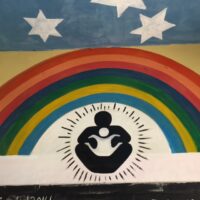 At Bhugathagalli a rural Anganwadi near Mysore, Leelavathi the Senior Supervisor shared the pre-schools philosophy for the children, the families and the community. The vision being clearly captured in the large painting on one of the walls showing the child at the centre connected to the mother, family and community...reminiscent of Brofenbrenner's theory of development.
At Bhugathagalli a rural Anganwadi near Mysore, Leelavathi the Senior Supervisor shared the pre-schools philosophy for the children, the families and the community. The vision being clearly captured in the large painting on one of the walls showing the child at the centre connected to the mother, family and community...reminiscent of Brofenbrenner's theory of development.
The mission of the centre was to;
- raise awareness and understanding of children's health and physical development through good nutrition and protection against illness and diseases. The government supplied nutritional supplements for pregnant and breast feeding mums and for the children as they got older
-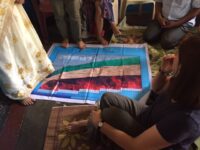 monitor the healthy growth of children (weight and height) using a development chart, very similar to those used by our Health Visitors. There were 3 zones a fire zone (red at the bottom), a sand coloured middle zone and a top zone of lush green grass which is where you hoped the children would be......easy to understand for everyone
monitor the healthy growth of children (weight and height) using a development chart, very similar to those used by our Health Visitors. There were 3 zones a fire zone (red at the bottom), a sand coloured middle zone and a top zone of lush green grass which is where you hoped the children would be......easy to understand for everyone
- support children's early learning including their home language and learning english which involved lots of singing; learning about the land (this was a rural Anganwadi in a small village) and being self-sufficient (one of the teachers had made a wonderful life size working model of a water pump for children to play with); a small pre-school kit supplied to all Anganwadi by the government included a puppet, some stacking blocks and letters of the alphabet. They also had colouring books and crayons
- 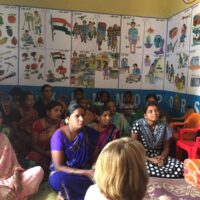 promote a funded government programme for mothers to develop their own small businesses from the dairy cattle being farmed in the village. Supporting entrepreneurship and listening to the mothers talking together with us about their children and education in the UK was fascinating - a meeting of minds as we all sat together on the Anganwadi floor
promote a funded government programme for mothers to develop their own small businesses from the dairy cattle being farmed in the village. Supporting entrepreneurship and listening to the mothers talking together with us about their children and education in the UK was fascinating - a meeting of minds as we all sat together on the Anganwadi floor
This is all part of the Balwadi Nutrition Programme (healthcare and education) launched by the Government of India in 1970, to provide food supplements for children of the age group 3–6 years in rural areas.
In brief the Balwadi Programme aims are to make India a 'child friendly' nation where children have a 'happy childhood' and they are
- cherished through freedom and love
- independent self-learners
- learning through their community and nature
- respecting others and learning values
- encouraged to be explorative, innovative and creative
As I sat listening to Leelavathi and Dinesh translating the mother's voices, it reminded me of the vision for our Children Centres, set in the heart of the community, supporting families and children, intervening early both in terms of health and education and the frequent success these centres had in engaging with young mothers, supporting them as well as their children and gradually seeing their confidence and self-esteem blossom.
Sad to think that we have lost many of our Children's Centres and Nursery Schools whilst India is clearly seeing them as the way ahead by bringing care and education together in an Integrated Child Development Scheme.
Watching Avinash creating a beautiful Rangoli pattern for Diwali made me think about how carefully and finely he was using his hands and fingers to place the sand in such intricate shapes, spaces and patterns. He placed a scoop of sand in the middle of his palm and then made a fist which acted as a funnel to carefully pour the sand out in fine lines. He used his fingers to mark out the shapes and create the clear lines of the pattern.
It made me think about the young children I had watched at the Door Step Anganwadi in Mumbai and how impressive they were in using their fine motor skills to create patterns and draw small, detailed pictures with their pens and crayons. These children were 3 and 4 years old..sitting on the floor in a very small space with about 14 other children.
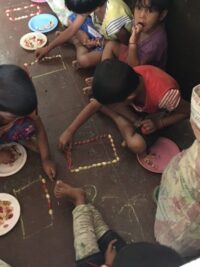 In one room children were busy using small coloured pistachio shells to make a frame around a rectangle which had been chalked on the concrete floor by the adult. Their concentration and hand eye co-ordination was impressive as well as their ideas about pattern making and sequencing (all mathematical skills) - we watched them as they busily got on with the task in hand.
In one room children were busy using small coloured pistachio shells to make a frame around a rectangle which had been chalked on the concrete floor by the adult. Their concentration and hand eye co-ordination was impressive as well as their ideas about pattern making and sequencing (all mathematical skills) - we watched them as they busily got on with the task in hand.
In the next small room the children were drawing flowers ( a theme they were following on flowers and growth). The careful, precise and detailed drawings were happening all around - we could see the way that they manipulated their pens (boys and girls) with confidence and without any pressure to draw or write..they were engaged, involved and enjoying the task taking great delight in showing what they had done to the teacher. The teachers then talk about the 'ideas the children have drawn and write down their story'.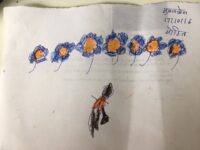
Hands and fingers are an important part of expression in India - we noticed this a lot as we saw people talking, cooking, dancing and making Rangoli patterns. The ancient practice of mhendi patterns on hands and feet (arms, legs) also shows the fine patterns that are everywhere in India. Fine beautiful paintings on the walls in Temples, palaces and old houses were another sign of delicate pictures and patterns though we were not allowed to photograph them 🙁
These are all an implicit part of children's culture and heritage which they seem to tune into naturally...its like an organic growth of their fine motor and hand-eye co-ordination without any pressure or formality to write. The origins being firmly in abstract pattern making and drawing rather than letter formation and the dreaded handwriting that our children are having to endure at even younger ages.
Maybe we need to take some note of this and think about more creative and organic ways we can support young children to become artists like Avinash?
Its my 4th day into the Nursery World Study tour in India and I am still having to pinch myself to believe that I am here.
I am trying to make sense of what I have seen and heard on the visits we have made to the pre-schools so far and what the key messages are for me (more on this in a later BLOG). To set this in context India has no compulsory pre-school education though there is a drive to lower the age range in the Right to Education Act to include the early years. There are 440 million children in India - that's a lot of children; 4% never start school and 58% don't complete primary school and there is little regulation, training or cpd though this is beginning to change.
The sheer size of India is staggering - in Mumbai there are children everywhere some living on the streets, sleeping in tent like structures on pavements and being left in the care of only slightly older siblings whilst parents and older children work. Children work on the streets trying to sell flowers, water and sweets to passers by - its a tough life. These children don't often reach a school.
Some children in the slums have the opportunity of schooling if there is a Balwadi or Anganwadi nearly by. These are pre-schools run by the Government or NGOs (National Government Organisations) we visited one called Doorstep School in Nana Chowk, Mumbai, which has been a highlight of the visits so far, more of which later.
There are also children living in wealthy homes with private schooling and all the usual luxuries that many children have in the UK. The contrast between these children's lives is a real challenge to deal with ....some are living in abject poverty whilst others are extremely well off - you see this contrast everywhere.
Its difficult to process the hardship these children experience but having seen them at Doorstep Anganwadi with their teachers you gain a sense of their resilience and eagerness to learn together. Mansi was the lead here who talked passionately about what she was trying to do for the families and children.
The following are some of the things she said
"We are breaking the cycle of poverty by empowering the children through education"
" Sustaining the children in the school"
"Parents are very important they are the main stakeholders in what we do"
"The child has to be at the centre - we knew this from the start"
"Capacity building" - we 'grow' our teachers from the community through training and support...which includes 2 Saturdays every month to share practice together and explore new ideas. She also said
"We want the children to use their minds so we talk with them and ask questions"
There are many connections here with what we want for our children but in comparison we are so lucky to have access to a strong child centred philosophy and early years provision despite the current challenges by a Government who don't seem to realise how important Mansi's beliefs are to children all over the world.
Door Steps mission statement is 'Education Moves On To Every Door Step' maybe it should be ours.....?
One of the most crucial aspects of our work with young children is to make sure that the decisions we make about children’s progress, our assessments, are as accurate, honest and respectful as they can be. That they really reflect what the child has shown us through their play, as we have observed them in their true state of development, as they become engrossed explorers, active learners and creative and critical thinkers.
If we can say that our starting points for making these decisions are based on the following questions then we are going to be in a strong position to make objective, professionally informed decisions (judgements) about children’s progress.
Asking the right questions for accurate and informed assessment of young children include;
What did I see here?
What is happening?
What is/are the child/children telling me about what they know and understand?
Ferre Laevers (2015) would want to know if we are ‘grasping the essence of what children are doing and getting into the position of the child’. He also says that we should be ‘Keeping an open-mind, taking a holistic view and actively thinking about what we are seeing’ as this will help us to draw considered and effective conclusions about children’s development and progress.
However, I am not sure that we are keeping an 'open-mind' or 'grasping the essence' in fact we seem to have gone down a road of assessing children using narrow, often superficial statements which do not fully acknowledge the breadth or depth of children’s development, thinking or learning. In doing so we seem to have lost sight of young children as the competent and capable thinkers and learners they are and we run the danger of underestimating their progress.
Development does Matter
One of the reasons assessment has become so narrow is the way in which Development Matters has been used as a developmental shopping list. This isn’t really the fault of Development Matters as it was never intended to be used in this way. Nancy Stewart, one of the original authors of the document, has written an excellent paper on this called ‘Development Matters: A landscape of possibilities, not a road map’ – it’s really worth a read and sharing with other colleagues. She highlights one of the main drawbacks as;
When used as a tick list of descriptors of what children must achieve, it can sadly limit both children’s development and the professional awareness and skills of practitioners.
In a previous Blog Why create the Development Map? I listed my concerns about the way in which Development Matters is being used and the risks to our understanding of children’s development and learning if we constantly use tick lists and highlighters;
Development Matters does help us in many ways and is an accepted, though not statutory, part of early years philosophy and practice – it is part of the EYFS Themes and Principles. It sets the context of children’s development within the EYFS through the following equation

The Unique Child is recognised from the outset and described as ‘Every child is a unique child who is constantly learning and can be resilient, capable, confident and self-assured’ (p2). The development statements are there as an aide memoir of ‘of common examples of how children might develop and give a general picture of progression, but they are by no means the whole story’ (Stewart. N – See above).
If we think of children’s development in the form of an ice-berg what we are seeing in the Development Matters statements is just the tip, equivalent to just 10% of their learning potential. Which means that there is a vast expanse (90%) of children’s potential that is not included in Development Matters! The danger is that using Development Matters as a list of assessment descriptors or hurdles to be jumped and the Early Learning Goals as a final destination means that children’s full potential is not recognised or valued. Where is the full potential of the competent and capable child recorded in our assessments if we only ever use a few statements to inform our judgements?
What can we do to make sure that we see the full potential of children’s development?
Development Matters is one tool of our assessment for learning repertoire but we could say, using the ice berg metaphor, that it is only 10%. There is much more to think about as we make our decisions about a child’s progress and many more ‘tools’ we can use to inform and strengthen or triangulate the judgements we make.
There are other tools we can add to our observation and assessment tool kit which support us to make professionally informed judgement about children’s progress. They include;
A good knowledge of child development; having a wide knowledge of child development which covers the holistic ways in which children learn and progress. Hopefully this has been a key part of initial and on-going training at all levels. The best way to keep your knowledge finely tuned is to observe children in their child-initiated play and activities. The more you observe, document and talk about this with others the more finely tuned your child development skills will become. Watching children is one of our best sources of learning.
The characteristics of development and learning; knowing HOW children think and learn is a crucial part of the jigsaw. It’s all about understanding the ways in which children Play and Explore (Engaged) and become Active Learners (Motivated) leading to Creative and Critical Thinking (Thinkers). These are the tools or dispositions for becoming a life-long learner, they tell us a great deal about what they know, understand and have mastered in their learning.
Children’s Schema and threads of thinking; are the inherent patterns of thinking that children instinctively show from birth. They are their earliest and most natural interests which drive child-initiated play and activities – we can see this in very young babies. Schema are the foundations of conceptual development underpinning later learning in maths including shape, space and measures, science and many other aspects of later development
Children’s interests and fascinations; are our window into their lives cognitively, socially and emotionally. Observing children in child-initiated play and activities lets us really see what they know and understand; what they have truly mastered and their emotional well-being. We can see how well they make connections with their previous learning and use this to forge new ideas and thinking. We can also see how they collaborate and relate to others, growing their personal and social skills and using language to build relationships and thinking.
Levels of Involvement and Well-Being; in themselves the involvement and well-being scales are used in many countries as a measure of children’s progress; it is called a Process orientated child monitoring system or POMS for short. They have been created by Ferre Laevers to not only identify how well children are progressing but also to evaluate the quality of provision and practice. Understanding the philosophy and practice of the Involvement and Well-Being scales will significantly strengthen the professionally informed judgements you make about progress from birth to the end of the Foundation Stage
Development of Speech, language and communication; is a critical and central part of children’s development and progress. The more we know and understand about the development of young children’s communication, speech, language and literacy the more we can understand children’s development and progress particularly in the first 3 years of life. There have been many initiatives which have focused on developing practitioner/teacher understanding including ECAT (Every Child a Talker), the Communication Trust and ican
SEND; understanding the wide and varied nature of Special Educational Needs and Disabilities will be a significant contribution to your knowledge and understanding of children’s development and progress
Developing your Observation and Assessment tool kit hopefully began with your initial training and has continued to develop through further opportunities for your professional development, adding to your professionally informed knowledge of children’s development. The more you can call on these tools the better and more robust your decisions will be about children’s progress. You will see so much more than just the Development Matters statements and be able to justify and triangulate the decisions you make about where you have placed a child on the continuum of development – ages and stages bands. Not only that, you will have as Nancy Stewart said, 'developed your professional awareness and skills'.
The Development Map has been created as a way of capturing and mapping children’s progress using your observation and assessment tool kit to inform where you place a child on the progress board. The intention is not to use the Development Matters statements as a tick list but to make a much more professionally informed decision about a child’s development, based on the way you and your colleagues have asked the questions at the beginning of this Blog, and looked at all the information and evidence you have to hand including that of the parents and the child. Then making a professionally informed, best -fit, summative judgement;
The summative judgement, however, must be as true as we can make it, and basing it on whether or not a child has matched every statement in an age/stage band is not a valid approach. There may well be statements missing, and statements demonstrated across two or three bands. The best-fit approach answers the problem by acknowledging that although not every child will have moved along in the same way, there is a typical movement. Identifying the band which most closely describes the child, based on what you know and have observed whether or not it has been recorded, will enable you to describe the child’s development in terms of whether or not it is typical for their age in the various areas of the EYFS. (Stewart. N)
Observation and Assessment Tool Kit self-evaluation
The Development Map will include an Observation and Assessment Tool Kit self-evaluation which will enable you to reflect on and consider the ‘tools’ you already have and ones you may wish to add in the future. It will support your professional development and identify aspects that you can work on and develop with your colleagues. It will be free for all Development Map partners.
For more information about the Development Map please follow this link or go to the WatchMeGrow website
Forth-coming Blogs;
Following the Observation, Assessment and Planning process, described in Part 1, means that you will have gathered an eclectic mix of evidence about a child which ultimately tells the story of their development and learning. For example:
This is your on-going assessment or Formative Assessment, described in the EYFS Statutory Duty as being ‘an integral part of the learning and development process’ (2.4, 2014) and in Development Matters (p.4, 2012) as being ‘at the heart of effective early years practice’.
Summative Assessments are also at the heart of good practice; these are your stopping off points to think about what this eclectic gathering of information is telling you about the child’s development and progress. Some helpful questions to ask yourself at these stopping off points are;
Summative Assessments should be made at regular intervals. More frequently for babies and toddlers as they grow and develop so rapidly, for example every 4 weeks. Older children may need a summative review every 6 to 8 weeks; whilst children with additional needs may need a review more often. There are currently two points at which you are statutorily required to make a Summative Assessment;
Ofsted also want to see the ‘progress all children make in their learning and development relative to their starting points and their readiness for the next stage of their education’ (146. p.30, Inspection Handbook, 2015, 150068) and;
With this in mind it is essential that everyone involved in young children’s development and learning (practitioners, teachers, leaders, co-ordinators etc);
And
The Development Map™ has been created to support both your Formative and Summative Assessments as well as show the ‘story’ of children’s development and progress. It is a ‘tracking tool’ which can be used in everyday practice for assessing children’s learning and progress through the EYFS. It views children’s thinking, learning and growth in a holistic way so that adults can see the ‘whole child’ and understand the complex nature of their development and progress over a period of time.
Lucy’s Development Map tells us a great deal about her learning journey and the progress she has made over a period of 9 months when something quite significant happened in her life.
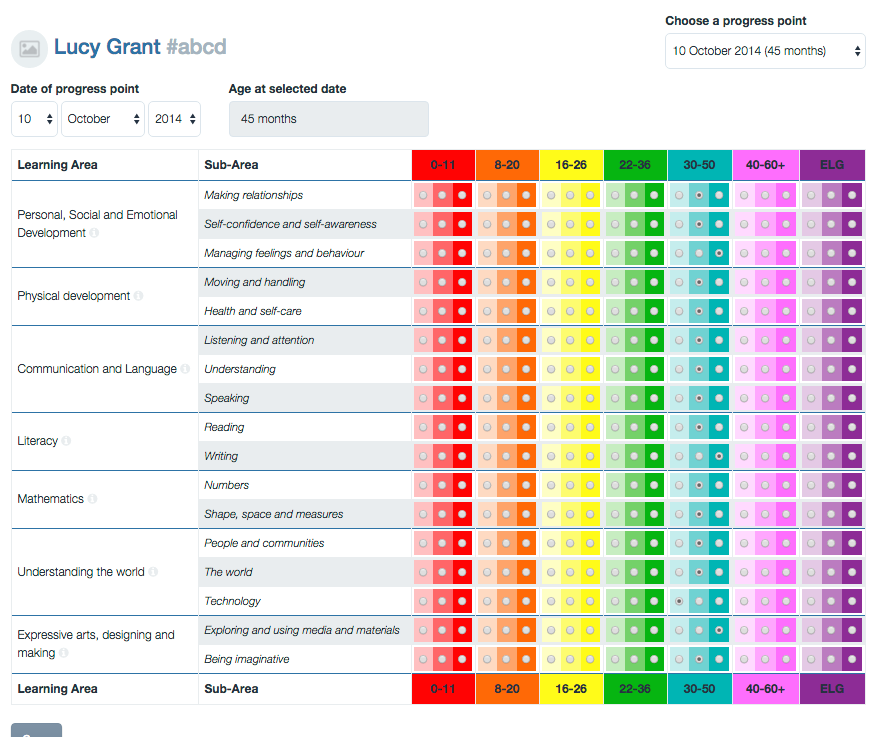
Through her observations of Lucy the key-worker had gathered a range of information and knowledge about her development and used this to make informed, professional judgements using the Development Map Summative Progress Board.
We can see Lucy’s story in her Development Map and what it tells us about her progress over 9 months. There are 3 Summative Assessment points at 36, 39 and 45 months.
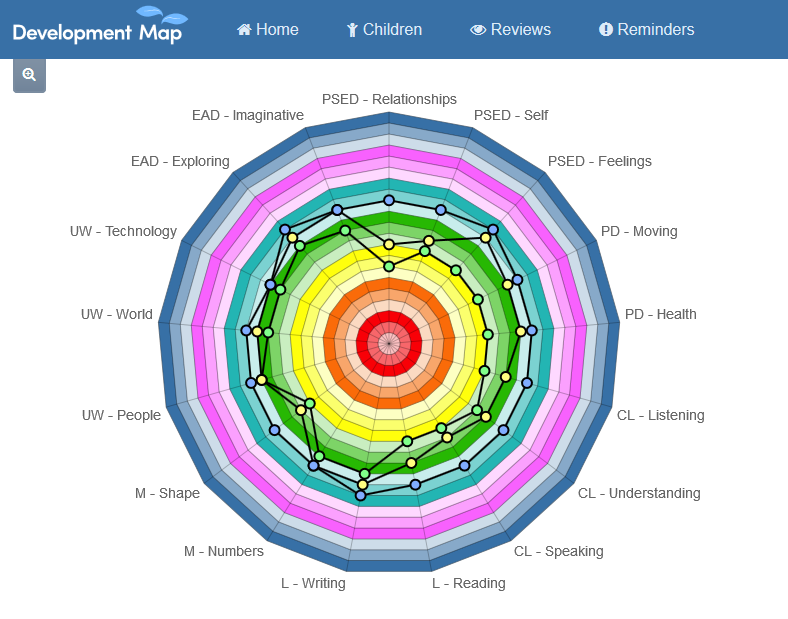

Lucy, at 36 months old (the green dot) , has quite a range of development across the ages and stages bands from Developing 16- 26 for Making Relationships to Secure 22-36 in Numbers, Writing, People and communities and Exploring and using media and materials.
We can see a significant spike[1] in her development in PSED at 36 and 39 months particularly in Making Relationships and Self-confidence and self-awareness, whilst she is making better progress in other areas of her development. The story behind Lucy’s spike is very common for many children her age; she is getting used to the arrival of her baby sister and has needed a lot of time, support and carefully planned next steps. The nursery team focused on Lucy’s interests in Technology, Numbers and Writing and used this to build her confidence, well-being and language development. By 45 months she was back on track having made 6 steps of progress in 9 months in Making Relationships.
The key-worker and nursery team expressed how well they could ‘see’ Lucy as a person in the Development Map and the holistic nature of her development. This really helped them when they spoke to Lucy’s mum and find out how things were going at home and to plan appropriate, meaningful, small next steps. Being able to make timely, informed and detailed summative assessments meant that they could identify where support was needed as soon as possible.
“Being able to talk about Lucy’s developmental journey using the Development Map was so easy; it made us think about her learning holistically and in the wider context of her home and family. We could see where she needed help and used the things she was doing well at and was interested to support her next steps”
Lucy’s Key-Worker
[1] I am not overly fond of the term spike but it does describe what the Development Map is telling us and we need to look out for these remembering that spikes can go either way inwards or outwards!
One of the joys and privilege of working with young children is to observe them as they play, talk, think and learn. Watching children gives us a real insight into their lives; their thinking; their emotions and their unique personalities. It is our window into their development and our invitation to play alongside, joining in as a play partner, a co-constructor and as a teacher[1]. Susan Isaacs recognised this in 1926 and wrote about the child’s world,
It cannot, of course, be very easy for us to gain a clear idea of what the world is like to a very young child, just because it must be so different from our own. But by patient listening to the talk of even little children, and watching what they do, with the one purpose of understanding them, we can imaginatively feel their fears and angers, their bewilderments and triumphs; we can wish their wishes, see their pictures and think their thoughts (Isaacs’s, 1929 p15).
Observation is a Statutory Duty (2.1, EYFS 2014) and accepted practice even though it is not a new process; think Susan Isaacs in 1926 and her well documented observations of children's play and development.
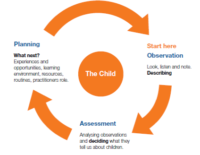
The Statutory Duty (2.1) of observation, assessment and planning is interpreted very well in Development Matters (p.4) and makes important links to good practice. It is very clear that the process begins with Observation and Describing what children are doing in their play and activities.
However there are certain things which worry me about the way we observe and how we put our observations to good use. For example we often use observations as a ‘shopping list’, looking for the things we want to see and tick off. How many colours does the child know? Can they count numbers up to 10? Do children know the names of a triangle, square and circle?
Focusing on check-lists and looking for surface level knowledge means that we miss the more complex, unique nature of children’s thinking, deeper level understanding and learning. We don’t look for or describe the mastery of their learning; the way children set their own problems and then look for solutions and the possibility questions they ask with their pointed fingers, questioning eyes and curious conversations.
If we make a single snap-shot observation, often jotted on a post-it-note as we pass by, and then make another one on our return what have we missed? It’s like an observation sandwich with the filling missing; we have failed to notice the most important part which involved the child or children working through a process of their own creation.
Good observation is about being able to do the following;
If we make sure that our observations primarily recognise HOW children are learning rather than WHAT they are learning we will have a much more secure foundation on which to base our Assessments. This means looking at the Characteristics of Effective Learning before you do anything else. You will this see much more in terms of children’s development and progress – you see them (from the start) as thinkers and learners. Try assessing (analysing and deciding what it is you have seen) by looking for the Characteristics of Effective Learning first. Then consider the WHAT….
WHAT children learn means looking at the knowledge, skills and content of learning; some of which can be found in Development Matters in the Areas of Learning and the Unique Child. A word of warning here though! Development Matters is not the complete guide to children’s development, if it was it would be enormous.
HOW and WHAT children learn is vast, especially in the first 5 years of their lives. To recognise and understand this we need to use a range of tools, not just Development Matters, so that we have a more robust understanding of children’s development. We can then make much more informed, professional judgements about their learning and the progress they make.
Good Assessment happens when we have observed well and then interpreted what we have seen in the most accurate way, taking many things into consideration, so that we can see the progress children are making, and how we can further support their thinking, learning and development. Avoiding a ‘tick-list’ approach to assessment is crucial for the reasons explained above and to avoid a narrow view of children’s potential development and progress. Development Matters affirms this in the footer of every page,
Children develop at their own rates, and in their own ways. The development statements and their order should not be taken as necessary steps for individual children. They should not be used as checklists. The age/stage bands overlap because these are not fixed age boundaries but suggest a typical range of development.
The key to this is triangulating the judgements you make in your assessments by considering other aspects of child development such as;
All these perspectives will lead to a better understanding of children’s development and help you to make stronger more robust, informed judgements about their development, learning and progress. Planning for children’s next steps and extending development will also be much more informed and personalised as you have a much clearer understanding of what experiences, opportunities, and resources to provide.
Look out for Part 2 - Mapping children's progress !
[1] We are all teachers – anyone who enters the lives of young children is a teacher as they play, talk, support and extend development and learning
Thank you for signing up to use the Development map with your children. I am hoping the following bits and pieces will be helpful as you start to use the Development Map
Helpful Tips from Michelle at Clockwork are
DM News and Updates:
Look out for the following which will be added to the Development Map Library and Resources in the coming months:
News and Updates will include our quarterly newsletters; links to the BLOG; local and national updates; Training and Support; helpful reading and reports and anything else important!
Phase 2 of the Development Map 2017 will include:
Hope this is helpful – do get in touch in the usual way
di.chilvers@watchmegrow.uk or enquiries@developmentmap.co.uk
All the best
Di
We live in a world (in England) of assessments, targets and goals which are increasingly taking over our perceptions of what young children are actually capable of thinking about and learning. Keeping an open and informed mind is difficult when there are pressures to tick a box or highlight a statement. But what do we do when we observe children and there isn’t a statement or box which adequately reflects what they know and understand?
If the tick lists and highlighters rule our understanding of children’s development we run the risk of
With this, and many other factors, in mind I wanted to take us back to good observational practice as required by the EYFS Statutory Framework (2.1 and 2.2). It’s the NNEB in me that wants to focus on what children’s play, interests and talk tells me about their thinking, learning and development and making an informed assessment of their progress from what I see. However, as with any informed ‘judgment’ I need to be able to back up my decision and ‘tell the story’ of the child’s development from their starting points.
The Development Map and the Observation Tool kit help me to triangulate the professional judgements I make about children’s progress and development…..
Watch out for the next Blogs on;
Its taken some time but the new website is live and after 4 years of principles, pedagogy and practice (bit of a mouthful) I have now morphed into WatchMeGrow. It's hard finding a new name that captures what I do but having started my work with children a long time ago by training as a Nursery Nurse (NNEB), where observation was (and still is for me) the starting point of everything, it seemed sensible to call the new website WatchMeGrow.
It's a real privilege to watch children as they play, explore, think , talk, discover and grow. It's also a real challenge as we try to understand what they are doing and why and then help them. Watching learning unfold in a truly creative and unique way where every child is different and you are never quite sure what will happen next.....it's the unexpected that makes working with young children so inspiring.
Have a look at the following story unfolding.... what do you think is happening as Jalilah plays with the bread crates?